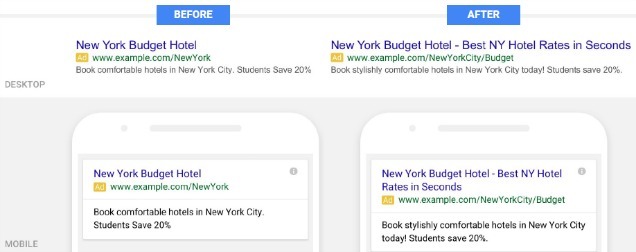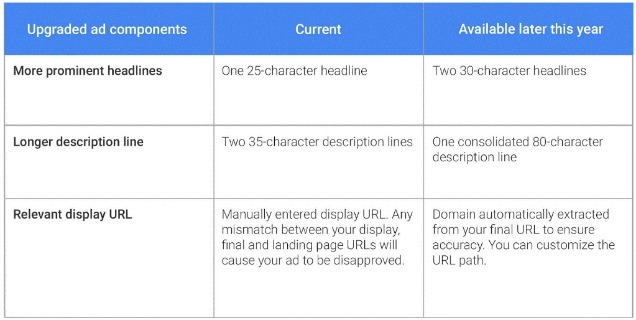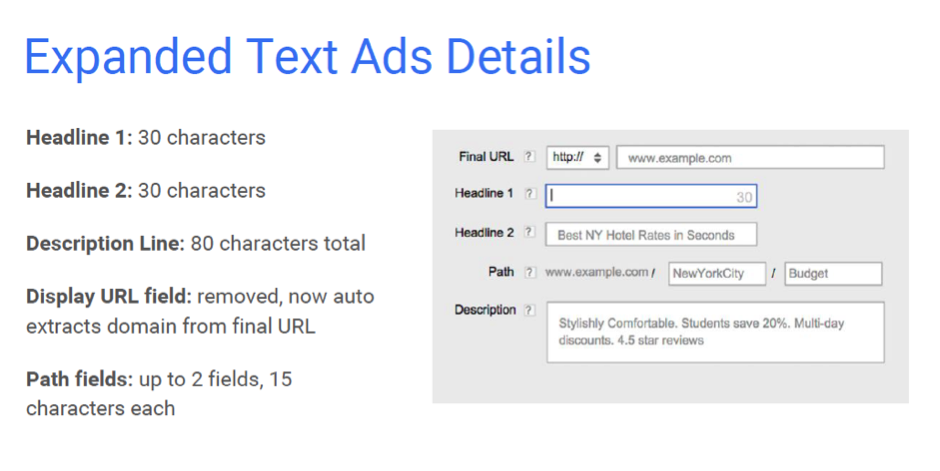What You Need to Know About ‘Expanded Text Ads’ from Google
It’s been a big year for Google AdWords. In the last 12 months, Google has:
- Changed the desktop ad layout—including discontinuing ads that appear in the right-hand sidebar of search engine results
- Introduced localized search ads
- Launched responsive display ads
But the one that has everyone talking: Expanded Text Ads. Allow us to give you a quick tour of Expanded Text Ads—and how your organization should seize this great new opportunity.
What are expanded text ads?
Expanded text ads are the new layout of Google AdWords ads. Here’s a before-and-after comparison from Google:

Until the arrival of expanded text ads, we marketers have spent years trying to stuff the most effective, creative, and compelling copy we could into the 25-35 characters that Google AdWords offered.
But lo, our Google overlords have bestowed upon as a gift: Two headlines and 80 characters of description space. (That’s 56% the length of a Tweet!)
Why do expanded text ads exist?
The “shift toward increased mobile use of the Web” is no longer approaching, it’s here. We are a mobile-first world—with more than half of Google’s three trillion annual searches occurring on a mobile device.
And Google has adjusted to this new normal with expanded text advertisements.
Expanded text ads (ETAs) offer two huge benefits:
- Ads now display consistently across all devices—desktop, smartphones, and tablets—thus enhancing the user experience.
- Advertisers have 50% more real estate on which to showcase product or service information—and (hopefully) compel searchers to click on the ad.
What do you need to know about expanded text ads?

Thoughts on marketing delivered to your inbox
You have 50% more ad text available, now what?
First, don’t pause your standard ads and simply replace them ETAs. Instead, take this opportunity to A/B test different calls to action and measure their performance. If expanded text ads don’t outperform your standard ads, continue testing and experimenting. Once your expanded ad outperforms your standard ad, you should begin running only expanded ads.
Write new ads!
Don’t simply add a second headline to your standard message. Again, take this new opportunity to analyze your AdWords account performance and invent new ways to use the extra characters—e.g., being more playful or provocative, adding new or additional value propositions, etc.
Headline #1 is much more important than headline #2.
Each of your two headlines can be up to 30 characters long. But headline #2 is less dependable because it can display in different ways—e.g., extending the length of headline #1, appearing after a line break, or even being cut off.
Headline #2 is the second most important part of your Google ad, but headline #1 remains champ.

If you use the path fields, they will come.
Expanded text ads automatically use your domain as your final URL. You’ve now been gifted with two 15-character path fields to insert top keywords that will improve your ad’s “quality score” and, consequently, reduce your cost per click (CPC).
Fill those path fields and never look back!
(On second thought, do look back. We should always be testing every aspect of our ads.)
Rethink your ad extensions.
Including deep links to your website via ad extensions will increase the effectiveness of your ads by letting you promote value that wasn’t included in the ad copy itself. As you write and experiment with new ad content, be sure your ad extensions don’t become repetitive. Google won’t show ad extensions that duplicate information already addressed in the text. You’ll miss opportunity to showcase other features, benefits, products, etc.
Employ a copywriter.
Expanded text ads are about 50% lengthier than the old, standards AdWords ads. Which means you have more room to flex your copywriting muscle. Even if your organization doesn’t do traditional print advertising, expanded text ads are a great, measurable way to experiment with your messaging to learn what works, what doesn’t, and what the difference is.
Standard ads are being phased out.
Beginning October 26, 2016, you will no longer be able to create a standard text ad within AdWords. All new ad creation and edits will be in the expanded text ad format. Standard ads created before October 26, 2016 will still be permitted to run alongside expanded text ads—but the quality score and clickthrough rate (CTR) will decrease.
The Final Verdict
The introduction of Expanded Text Ads (ETAs) is exciting for us AdWords geeks. The changes happening to Google AdWords is exciting and vast. As we become more familiar with expanded text ads—and all of Google AdWords’new offerings—we’ll be on the right track to navigate marketing in our mobile-first world.
Let one of Mighty Citizen’s expert digital marketers help your organization craft an effective, measurable, and valuable online marketing campaign. Simply contact us to get the conversation started!

